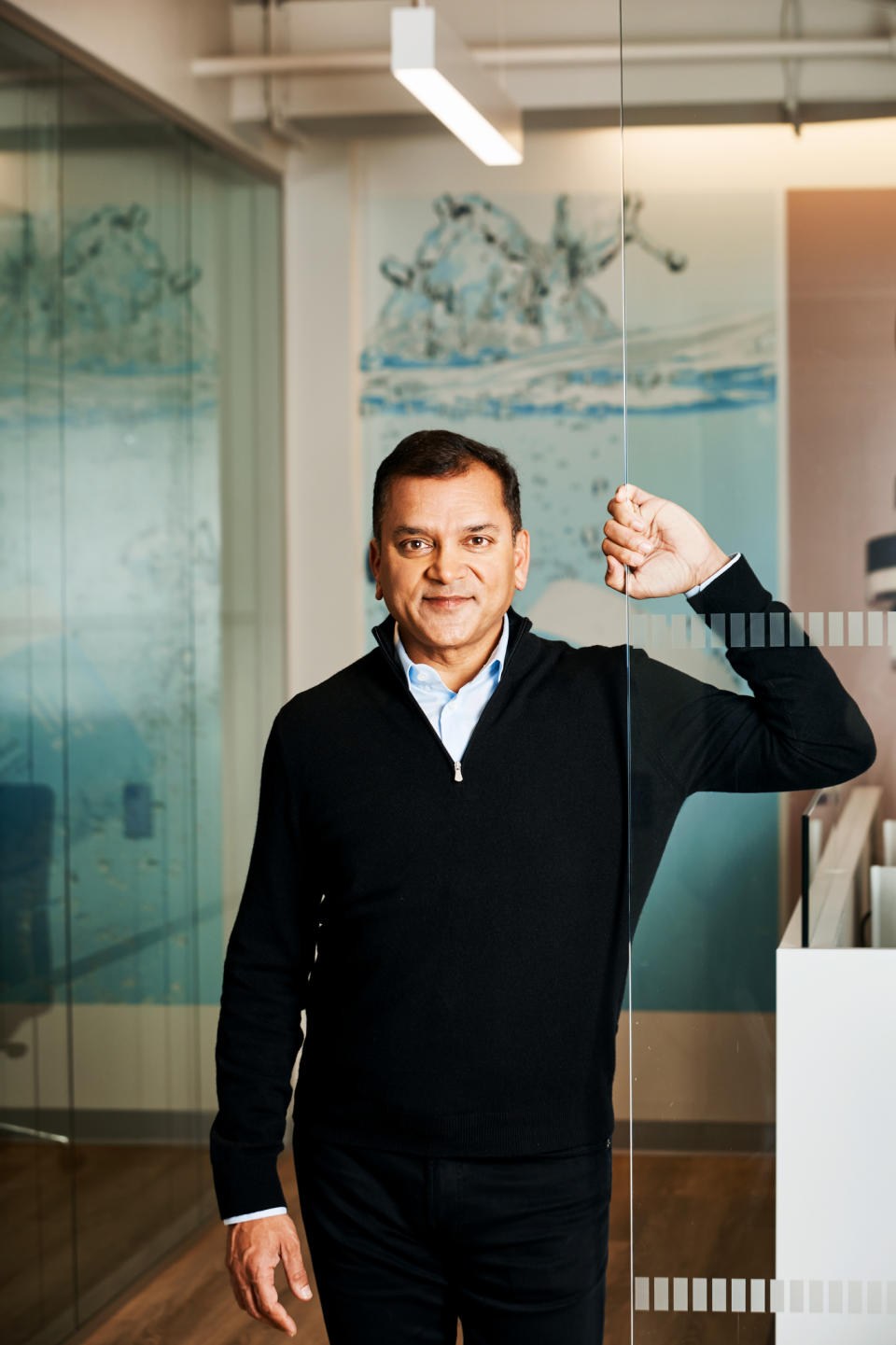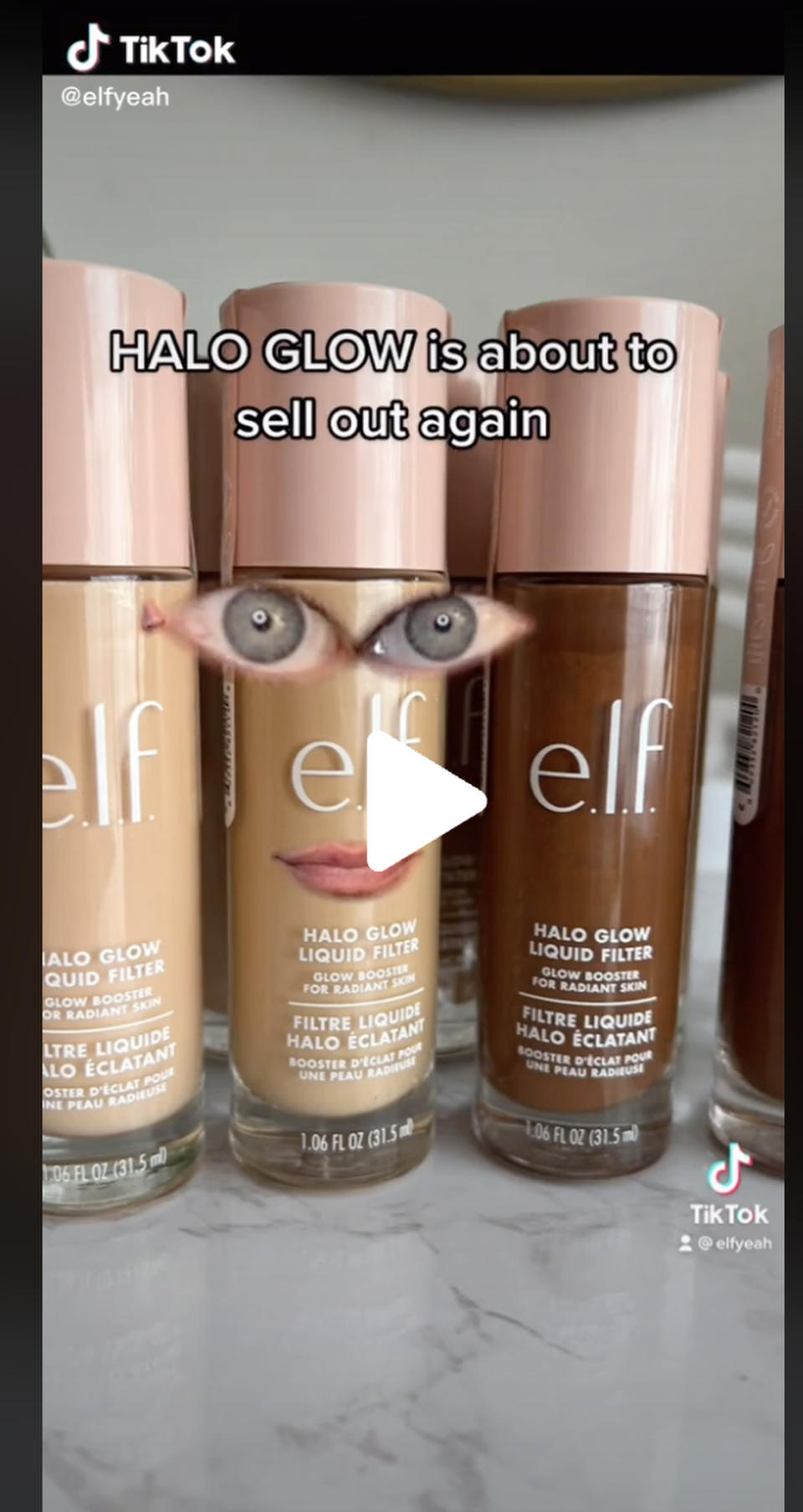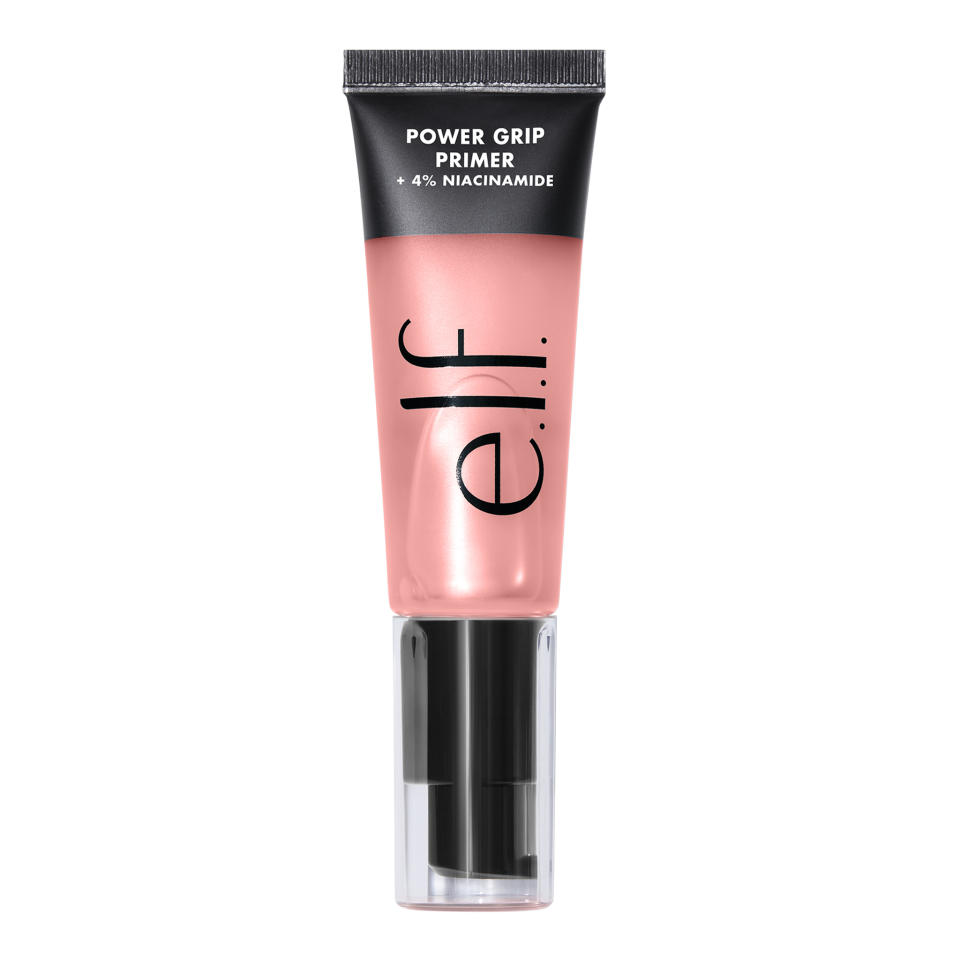Inside E.l.f. Beauty’s Oversized Success

More from WWD
E.l.f. Beauty turned in one of the best performances of a publicly traded company in 2022, but if you think chairman and chief executive officer Tarang Amin has all of the answers when it comes to navigating an enterprise through a rapidly transforming and very volatile business landscape, you’d be wrong.
He’s got all of the questions.
For Amin, who has been leading the company for the past nine years and notched his 16th consecutive quarter of growth earlier this year, who oversaw a 78 percent increase in share price in 2022 (versus a 19 percent decline for the S+P 500) and an expected 38-39 percent sales increase to $545 million for FY 2023, curiosity is the key to E.l.f.’s oversized success.
Ask him one question and you’re likely to get two, three, four in return.
“What are the opportunities to eliminate waste?”
“Why can’t we go faster?”
“Are we meeting our community’s value standards?”
“The Weather Channel and E.l.f.? How do these things go together?”
Those who have spent time with Amin know the questions pour out, from the conventional CEO query to the more unexpected.
“I naturally have a lot of curiosity,” Amin said, during a wide-ranging interview in the company’s Flatiron-area New York City office.
“The longer I’ve been in business, the more questions I ask. I learn a lot and it creates a culture where that is the norm. We want you to be curious, we want you to engage on topics well beyond what new product we’re making. One of the big differences in our culture is we are seeking the truth, seeking learning, and then putting that into action.”
When Amin says action, he means it. E.l.f., which has a market capitalization of about $3 billion, brings products to market in as little as 13 to 20 weeks, thanks to a product development and marketing machine that works concurrently rather than sequentially. That model enables the brand to “work at the speed of culture,” as E.l.f. executives say.
“It’s less about the time as much as we are able to take the energy of the team and make good ideas happen faster,” said Amin. “It’s the unique ability of balancing speed, quality and costs. Most companies usually pick one or two of the three. It’s our insistence that we need all three.”

The strategy is working. Of the top five mass market color cosmetics companies — Maybelline New York, L’Oréal Paris, Cover Girl and Revlon — E.l.f. increased its share by 150 points in FY third quarter, according to Nielsen, almost twice that of closest competitor Maybelline, which saw an increase of 65 points. According to Piper Sandler’s 2022 Taking Stock of Teens survey, E.l.f. is Gen Z’s favorite makeup brand and a top 10 favored shopping destination.
Thus far this year, the stock has increased, from $55.34 on Jan. 3 to $73.77 at press time, with most analysts bullish on the company.
“One of the hallmarks of Tarang and E.l.f. is speed,” said Oliver Chen, managing director and senior equity research analyst covering retail and luxury goods at Cowen. “They aren’t afraid to test read and react. They’ve been early pioneers in rethinking social and the evolution of the new customer. They execute quickly — both in product innovation and marketing engagement — and the speed helps them increase their relevance with consumers.”
That willingness to experiment is what has enabled Amin to pull away from the pack. But it wasn’t always so. While the company thrived during the pandemic, not so long before, in 2018, E.l.f. hit a wall.
“We had two quarters in 2018 where we were minus 3 percent. Which post-pandemic doesn’t seem that traumatic,” said Amin. At the time, though, the CEO had to implement some significant changes, including closing E.l.f.’s own stores, doubling down on digital, rethinking its product development strategy and launch cadence, and bringing in new blood to better leverage E.l.f.’s core strengths of speed and value.
“The best time to innovate is when you’re on top versus when you hit a struggle,” he said, when asked the biggest and most enduring takeaways from that time. “I’ve asked every one of our directors and above to answer the questions: What has to change? What stays the same? What else do we want to keep? What do we have to add?”
Kory Marchisotto was one such addition when she was brought on board as chief marketing officer of E.l.f. and president of Keys Soulcare, in 2019. A beauty veteran with experience primarily on the prestige side, Marchisotto is bold, brash, fast and fearless, adept at breaking ideas down into easily digestible and repeatable sound bites.
One of her very first actions when she joined the company was to dig deep into the community, “the die-hards, the super fans, the never-leaves, the lifetime E.l.f. enthusiasts,” as she calls them, to understand what they loved most about the brand.
The next step was to create an E.l.f. lexicon — ‘elfing amazing,’ etc. — which has since become a shared language both with employees and the community at large, which was deployed across the company’s content universe.
But it was a chance meeting with her 16-year-old nephew’s girlfriend, who told Marchisotto that Instagram was the social media platform she went to when she wanted to feel bad about herself, while TikTok was the place she went to be herself, that really sparked a fire.

That was in 2019, and while today, TikTok is the most influential platform for Gen Z and beauty, back then, only a few brands were participating. Marchisotto decided to go all in, commissioning a branded #Eyeslipsface anthem, which proved to be so popular it hit the Billboard charts and catapulted E.l.f. directly into the hearts and minds of Gen Z.
“If you want to serve your community you have to be part of it. It sounds simple. It’s not,” said Marchisotto, who scans E.l.f.’s social platforms daily. “I read thousands of comments weekly. I stay tuned in with their wants, their desire. We don’t wait for reports, decks, proposals. Are reports important? Of course,” she continued.
“But if you want to be in lockstep with the community, you have to feel the vibe, feel the energy — and translate that into action in real time. We keep the community engaged by transcending the transaction. We create an orbit people want to be part of, which is a very different thing than waking up every day and saying, ‘I want to sell people product.’”
Since that first campaign, E.l.f has created numerous TikTok initiatives, garnering more than 10 billion views and nearly 7 million user generated videos, according to The Shorty Awards, which honor outstanding achievement in social media, and has been early — often first — on emerging platforms like BeReal and Twitch.
“We’ve created a constant drumbeat of thumb-stopping creative,” Marchisotto said. “A constant drumbeat — not a piece of content and push it out.”
E.l.f. has also significantly increased its marketing spend from 7 percent of revenues in FY 2019 to 16 percent in FY 2022, still slightly less than many of its competitors.
“They’re willing to take bigger bets with respect to advertising and brand support,” said Olivia Tong, managing director, senior consumer and beauty analyst at Raymond James. “They’re growing, but they’re also investing in their business, and that gives you an opportunity for sustainability.”
While E.l.f. is continuing to leverage TikTok, it’s also actively exploring other areas, and being first is as important as being fast. “The consumer is constantly desiring innovation and something that will enable you to engage with them in new ways,” said Ekta Chopra, E.l.f.’s chief digital officer, who outlined three key areas her team is focused on.
The first is gaming, with platforms like Twitch, and the evolution of the metaverse and Web3.0. The second is generative AI, particularly Jasper.ai for copy writing, Dall-e 2, which can create images and visuals from language, and ChatGPT, an artificial intelligence text generator.
The third is data, which Chopra likens to oil. “You constantly need to refine it,” she said. The most robust source of actionable data is E.l.f.’s 3.5 million loyalty club members, who spend 10 minutes on average on the brand’s app versus 2 minutes for a nonmember and who purchases twice as much on the app.
“They tell us exactly what they like, what they dislike, how they feel, what we should do. My response is to build that trust and make sure we don’t break it, in the form of giving them the personalized experience they are looking for, the products they desire, talking to them when they want to be spoken to in the form they have chosen,” said Chopra. “They help us understand the products we have to build. What are consumers actually buying? What are the complementary products? Where are the issues? Then we leverage this data to optimize how we spend our paid money dollars.”
While Chopra consider’s E.l.f.’s speed in testing and learning across digital platforms to be a key component of its success, that doesn’t mean the brand is jumping on every new platform. “We’re the number one Gen Z brand, because we listen to them and we show up in the places where they want to go and already are,” she said.
Currently, that means experimenting with the metaverse and understanding what value the brand’s involvement delivers to consumers. “Many people think of NFT’s as a collectible for people who can afford it,” said Chopra, “but for us, we’re thinking — if an E.l.f. loyalty member has an NFT or their loyalty card is an NFT, what is it unlocking for them? Just like our rewards system enables them to redeem their points in a variety of ways, like a third-party retailer gift care, maybe with this we give them an experience, like tickets to Coachella. So it is connecting the physical to the digital — that’s what I mean by value.”
While the focus on experimenting and results resonates well with analysts, E.l.f. is not necessarily immune to outside factors, increased competition and the continued volatility of the economy. “You get to a certain size and you have to do more — what used to be able to move the needle is no longer enough,” said Tong. “The stock did incredibly well last year so it’s on a lot of radar screens and the multiple has come up. The street has higher and higher expectations and it’s going to be harder and harder to meet those.”
E.l.f. executives are confident that they have plenty of room for growth. On a corporate basis, it has the brands Well People and Keys Soulcare, both of which enable it to play in the rapidly expanding universe of wellness-oriented offerings.
And even with the flagship brand’s stellar performance over the past two years, executive say there is ample room for growth. “We have a long runway ahead of us. We’re just getting started,” said Mandy Fields, senior vice president and chief financial officer. “In the U.S., we are the number-four ranked brand in mass, but the runway to get to number one is massive — a lot of white space opportunity.
“With skin care, we have less than a 1 percent share in a huge category that is $5 billion at mass. We are barely scratching the surface. And only 13 percent of our business is international, so there is huge opportunity there.”
The U.K., where E.l.f. ranks eighth, and Canada, where it is seventh, are currently the two largest markets outside of the U.S., and Amin believes that E.l.f. can achieve top-five status in each market. He is also very bullish on India, and E.l.f.’s partnership with Nykaa. “We started with an e-commerce business in China, which is doing OK, but India is just a much better market for us — it’s much more oriented to the kind of value in the mass market and being English-speaking helps with social media and engagement,” he said. Most recently, Amin hired a new vice president for international and is building out the team in the U.K., to oversee a sequential expansion into Western Europe.
Expanding E.l.f.’s purview in skin care also represents a significant opportunity. Last year, the company carved out skin care to be its own vertical and “is seeing tremendous results,” said Amin, noting that E.l.f.’s skin care sales are growing at 40 percent, versus overall category growth of 6 percent.
In terms of product launches, the company will duplicate its “holy grail” strategy for skin care coupled with the value proposition that has worked so well, making products usually available only in the prestige market accessible at mass for a fraction of the price. “Right now, our bestselling product is the Power Grip Primer, which sells for $10. But the only other thing like it is a $34 item at prestige,” said Amin. “More than two-thirds of Americans live paycheck to paycheck and a lot of what they aspire to in beauty is inaccessible. We expand the category by bringing accessibility to millions of consumers who otherwise wouldn’t experience such a product.”

In terms of skin care, key launches this year include Youth Boosting Advanced Night Retinoid Serum, $22, and Suntouchable! Whoa Glow SPF 30, $14.
“Tarang and his team have built the business through powerful, breakthrough innovation, both with the products they offer and the way they connect and engage with the consumer, particularly Gen Z,” said Dave Kimbell, chief executive officer of Ulta Beauty, who characterized Amin as a “gracious, kind and humble leader.”
“Reflecting Tarang’s style, the E.l.f. team are exceptionally nimble and disruptive brand builders,” Kimbell continued, “while always rooted in deep understanding and smart strategic direction.”
That combination has proved a winning bet at retail, where E.l.f. continues to expand its space. This year it will gain ground in select Walmart, Target and CVS stores in the U.S. and Shopper’s Drug Mart in Canada. Amin cites the brand’s performance in Target, where it is number two behind Maybelline New York, as proof that E.l.f. isn’t close to reaching peak performance.
“At Target we’re on a trajectory where if we continue the momentum that we have, maybe in the next year or two, we might even pass Maybelline,” he said, noting that while E.l.f.’s national share is a 7 on average, at Target it is 14. “That’s significant because, as our first retail account, Target had a head start by years over other customers and we see other customers on that same trajectory.”
Meanwhile, Target continues to grow, too. “When we were the first retailer to carry E.l.f. in our stores back in 2008, we knew this was a special company and its incredible growth at Target proves that,” said Christina Hennington, chief growth officer of Target. “I’m proud of the platform Target provides for emerging, purpose-driven brands. With today’s consumer, especially our Gen Z guests, that’s a competitive advantage. That’s why E.l.f. is one of our fastest-growing beauty brands and why there’s so much potential in front of us.”
Those who know him well describe Amin as a kind-hearted, empathetic and highly communicative leader. He doesn’t just talk the team talk — he lives it. Everyone who joins the company is given a Myers-Briggs Type Indicator test (Amin himself is an ENFP, which stands for extroversion, intuition, feeling and perception), to enable them to better understand their colleagues.
“We want you to understand your preferences and those of your teammates,” Amin said, “and then we train them on how to give feedback. How do you foster that curiosity and conflict to bring up the best results. We find often those moments of healthy conflict is where the real breakthrough comes in.”
Amin has been equally as intentional in creating a diverse workforce. It is one of only four public companies in the U.S. with a board of directors comprised of at least two-thirds women and one-third minority representation; and its workforce of 330 is over 75 percent women, over 60 percent Gen Z and Millennials, and over 40 percent diverse.
“Our employee base is a competitive advantage,” said Amin. “First and foremost, everything goes back to the community. The community we serve cares about more than just the quality or price of a product.”
To that end, E.l.f. reformulated its entire line to be vegan and cruelty free and clean and was the first beauty manufacturer in the U.S. to achieve fair trade certification for a manufacturing facility. It has issued an annual Impact Report detailing its environmental, social and governance initiatives and was named one of Fortune’s best places to work in 2021.
No wonder that Amin is extremely optimistic as he prepares for the year ahead, despite the macro headwinds — and as always, there’s a crucial question.
“First and foremost, I’m really quite bullish,” he said, when asked about the year ahead. “We’re particularly well positioned with our fundamental value proposition, our innovation engine, our marketing.
“The biggest challenge for me is not the growth that we have ahead of us. But how do we sequence it and approach that growth in a disciplined way?
Best of WWD

